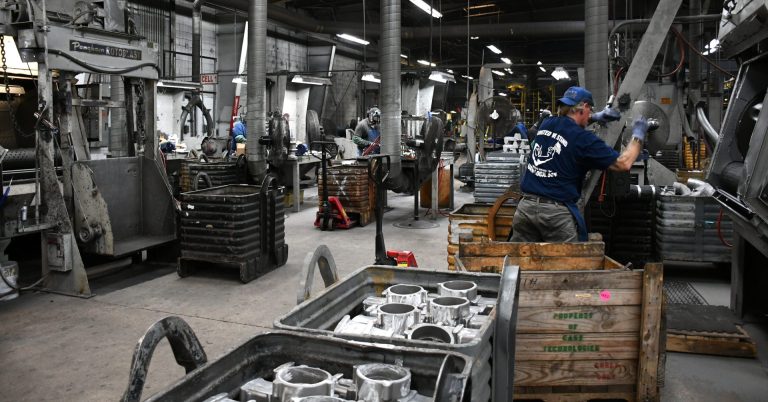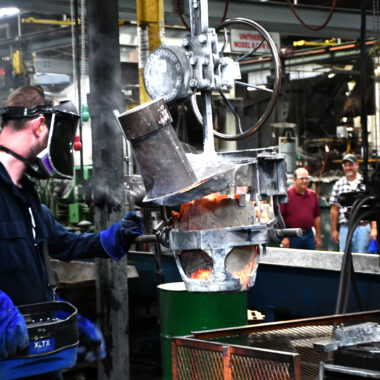The Ultimate Overview to Aluminum Casting: Expert Insights and Best Practices
Wiki Article
Study the World of Light Weight Aluminum Casting: Comprehending the Different Approaches
Light weight aluminum casting is a basic procedure in the production sector, with different approaches employed to produce intricate and precise elements. From the standard sand casting approach to the advanced die spreading procedure, each technique supplies unique benefits depending on the demands of the job.Sand Casting Method
Sand spreading, a widely-used technique in light weight aluminum spreading processes, includes creating mold and mildews made of compacted sand for putting liquified metal. Once the mold is all set, it is safely placed in a flask and molten light weight aluminum is poured right into the tooth cavity.After the metal has actually cooled and solidified, the sand mold is escaped to reveal the aluminum spreading. Sand spreading permits for the manufacturing of complex shapes and large components that might be difficult or expensive to create utilizing other methods. It is also a lasting strategy as the sand can be recycled and used numerous times, reducing waste in the spreading procedure.
Long-term Mold And Mildew Method

One considerable benefit of the Irreversible Mold Strategy is the improved dimensional accuracy it uses. The steel mold and mildew permits tighter resistances and better information in the final aluminum castings contrasted to sand casting approaches. This accuracy makes it a preferred option for applications where limited dimensional control is important, such as in the aerospace and automotive markets.

Pass Away Casting Refine

Investment Casting Method
Utilizing an accuracy casting approach, Investment Casting Strategy entails creating complex aluminum elements by pouring liquified steel into a ceramic mold. This procedure, likewise known as lost-wax spreading, starts with the creation of a wax pattern of the desired part (aluminum casting).Investment casting is commonly made use of for producing elements in sectors where tight resistances and detailed layouts are required, such as aerospace, auto, and medical devices. The adaptability and accuracy of the Financial investment here are the findings Casting Method make it a useful method in the world of light weight aluminum spreading.
Lost Foam Spreading Method
Having actually discovered the intricate accuracy of Investment Casting Approach, the emphasis currently shifts to the cutting-edge method of Lost Foam Spreading in light weight aluminum part production. Lost Foam Casting, additionally known as evaporative pattern casting, is a modern-day strategy where a foam pattern of the desired component is developed and you could try these out after that coated with a refractory material.In Addition, Lost Foam Spreading is an economical process as it minimizes the demand for cores and permits for the manufacturing of light-weight parts. In spite of its advantages, Lost Foam Spreading requires mindful control of the spreading procedure to avoid flaws and make sure top quality parts.
Final Thought
In conclusion, aluminum casting uses a variety of approaches such as sand spreading, long-term mold and mildew technique, pass away spreading, investment spreading, and lost foam spreading. Each method has its own benefits find more and applications, making light weight aluminum casting a versatile and extensively utilized process in various markets. Understanding the distinctions between these methods is crucial in choosing one of the most suitable spreading strategy for specific manufacturing requirements.Sand casting, a widely-used method in light weight aluminum spreading processes, includes producing mold and mildews made of compacted sand for putting liquified metal. aluminum casting.The Long-term Mold Method, like sand spreading, is one more widespread technique used in aluminum spreading processes, using distinct advantages in terms of mold reusability and dimensional accuracy. The metal mold enables for tighter tolerances and finer details in the last light weight aluminum castings contrasted to sand spreading approaches. The 2 primary types of die casting are cold chamber pass away casting and warm chamber pass away spreading, each ideal for various kinds of aluminum alloys.In conclusion, aluminum spreading supplies a selection of techniques such as sand casting, permanent mold strategy, die casting, investment spreading, and shed foam casting
Report this wiki page